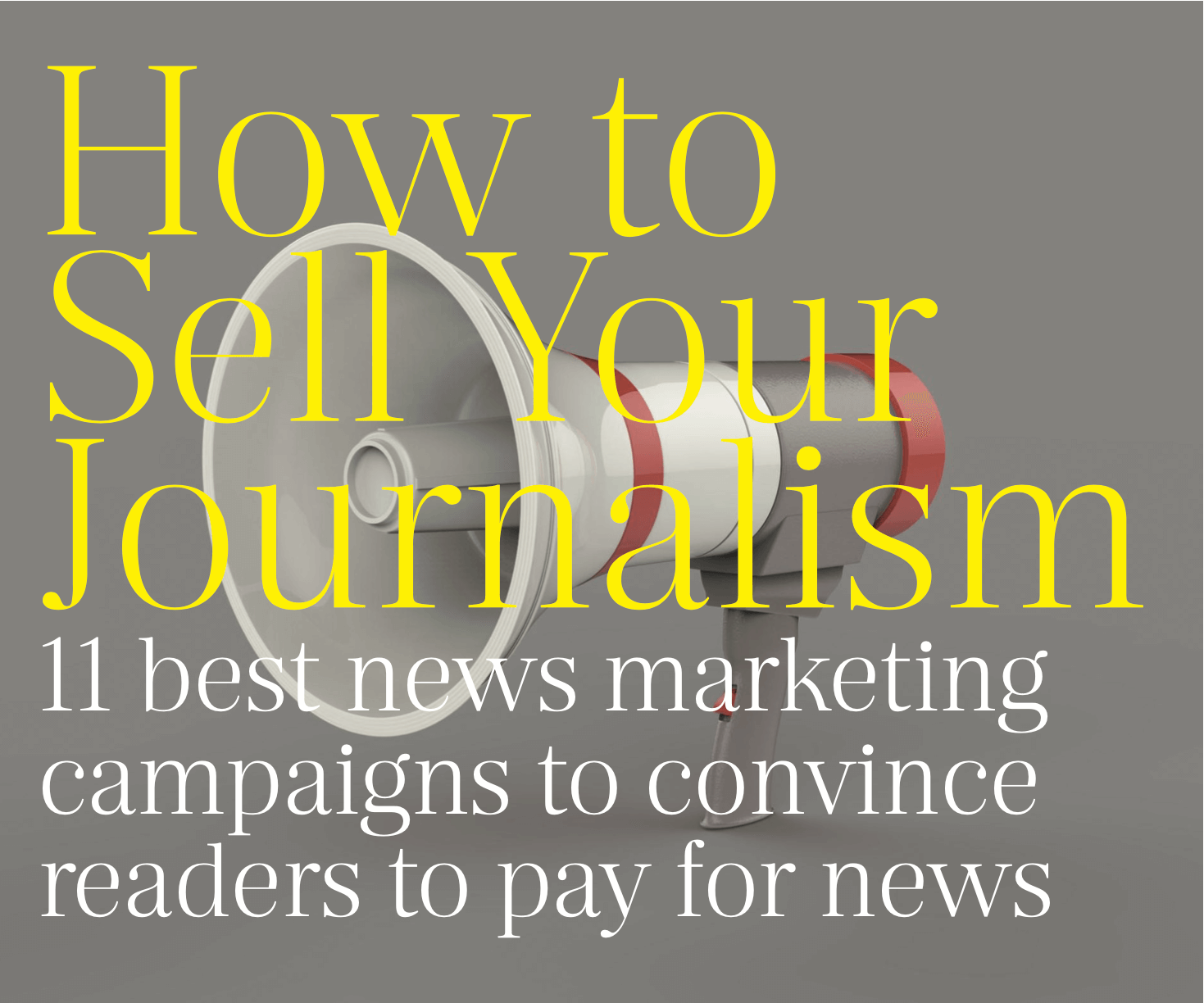
20 Jun How to Sell Your Journalism
11 BEST NEWS MARKETING CAMPAIGNS TO CONVINCE READERS TO PAY FOR NEWS
A global pandemic, a historic U.S. election and a reckoning over race and civil rights were among the once-in-a-lifetime stories that encouraged audiences around the world to seek expert information and coverage and place their trust in valued newsbrands over the past year. The surge in subscriptions that followed was organic, but also driven to a large part by innovative marketing campaigns by news organisations designed to meet this breakthrough moment for the industry. Ranging from emotive messaging on bringing calm
and clarity in uncertain times, to emphasising the historical bonds that news organisations share with the communities around them, in this chapter we give an overview of the best campaigns to sell journalism over the past year.


The New York Times USA
Life Needs Truth
The New York Times launched the “Life Needs Truth” campaign over 2020 and 2021, focusing on the paper’s role in helping readers understand the world around them. The campaign weaves together headlines and images from nearly 100 pieces of Times journalism, capturing the complexity of life in this moment, and is a thematic continuation of other award winning campaigns the publisher has run over the last few years such as “The Truth is Worth It” (2018) and the “The Truth is Hard” (2019).
“Whether it’s helping with life at home; navigating a new economy; keeping current with culture; tracking a new administration; or understanding the vaccines, the new wave of ads from our campaign highlights how The Times can help readers navigate the biggest stories of the day and find moments of discovery and relief,” the Times’ marketing team wrote in a note describing the campaign. Aside from news stories, the campaign also highlights the Times’ expand- ed lifestyle coverage and service journalism over the last couple of years, particularly its launch of a popular Sunday print section called At Home which ran till May 2021.
De Morgen Belgium
Kaleidoscope campaign
2020 was a year characterised by uncertainty and as it came to a close, the Belgian newspaper De Morgen wanted to design a campaign that would allow readers to look back, and reflect, with a sense of perspective and calm. The Kaleidoscope 2020 campaign, part of the p[ublication’s larger ‘Clearly De Morgen’ branding, does just this — inviting readers to interact with a responsive website with twelve interactive kaleidoscopic scenes: one for each month of 2020, built with elements that represent that month’s most important news items.
Users can interact and play around with the kaleidoscopes as well as discover the news articles that relate to each visual element within. A quick preview of the moving kaleidoscope can also be seen by hovering on each month.
Going into 2021, the aim was both to entice readers to make sense of the tumultuous months that characterised 2020 while also attracting new readers and subscribers by triggering their curiosity. The campaign continued the brand evolution that De Morgen started in 2019, positioning itself as the bringer of clarity in unclear and chaotic times. With the kaleidoscope concept De Morgen managed to increase top of mind attention by 40% and increase the number of paying readers by 20%, the publication submitted at the 2021 INMA global media awards.
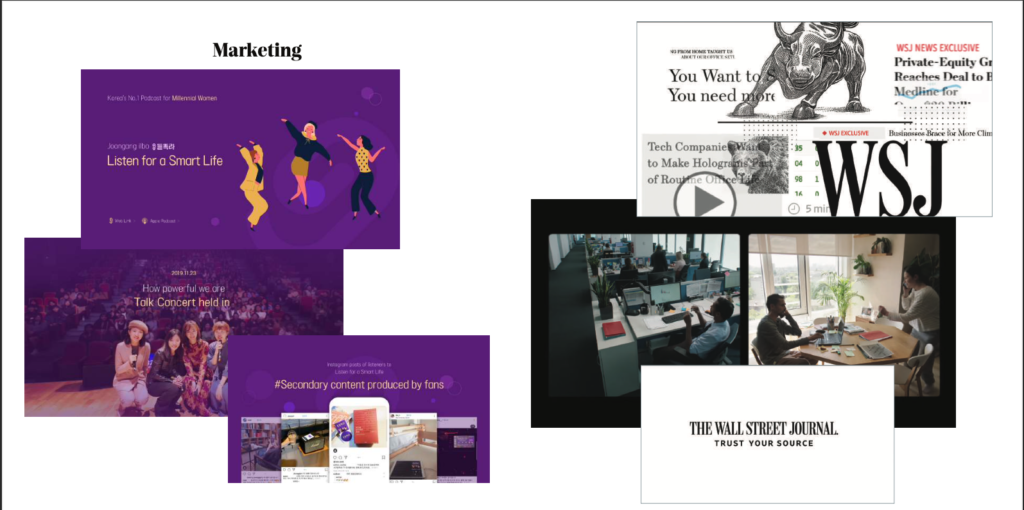
The Joong Ang Ilbo South Korea
Listen for a Smart Life, Millennials’ Current Affairs Friend Campaign
During the initial days of the Covid pandemic the world was awash in panic
and misinformation of all hues spread like wildfire. The Korean news daily JoongAng llbo found that millennials in particular started turning to social media for news over traditional channels and were inevitably more exposed to fake news.
Under a new audio news service called Listen for a Smart Life, the publisher launched a campaign called Millenials’ Current Affairs Friend, seeking to regain ground as a reliable source of information for millennials. News was conveyed in a conversational tone with millennial reporters approaching issues with a ‘let’s find out together’ attitude rather than an assertive tone. And content was presented through mediums like YouTube, podcasts and social media.
The result was innovative news initiatives like the ‘One Health Project’, initiated during the Covid-19 crisis, focused on why zoonotic diseases continue to occur and the fact that the health of humanity depends on the integrated management of animals and the environment. “LSL had roughly 90,000 subscribers at the end of 2019. Since producing targeted interactive content, that number has jumped to 400,000 as of January 2021. More than 70% of subscribers are our target audience of millennial women,” the publisher reported.
Wall Street Journal USA
“Trust Your Decisions”
Launched in early 2021, the Wall Street Journal’s “Trust Your Decisions,” campaign focuses on the role the publication plays in readers’ decision-making processes in business, finance and in their personal lives. The campaign represented a shift in messaging from WSJ’s last major marketing push, the “Read Yourself Better” campaign in 2019 that was centred on tackling misinformation. According to reporting from Digiday, “Trust Your Decisions”, was influenced by research from the WSJ’s customer intelligence team which found that 60% of WSJ prospective readers had postponed major decisions (in finance, investing, career and health) until the pandemic was over, but also that WSJ members were more likely to see opportunity in making those big decisions.
The Journal’s inclusion of the word “trust” in the campaign’s name is meant to give the publication’s subscription push a boost. The term is “connected to the willingness to pay,” Suzi Watford, EVP, Consumer at the WSJ’s parent company Dow Jones, told Digiday. Aside from ads in print, online and physical locations, the WSJ also sold merchandise with the word “Decision Maker” emblazoned on mugs and T-shirts to media and marketing influencers. The phrase was also integrated into the Journal’s events and across its business, such as at the “WSJ CEO Council” and its flagship event, “The Future of Everything Festival”, on May 11-13.
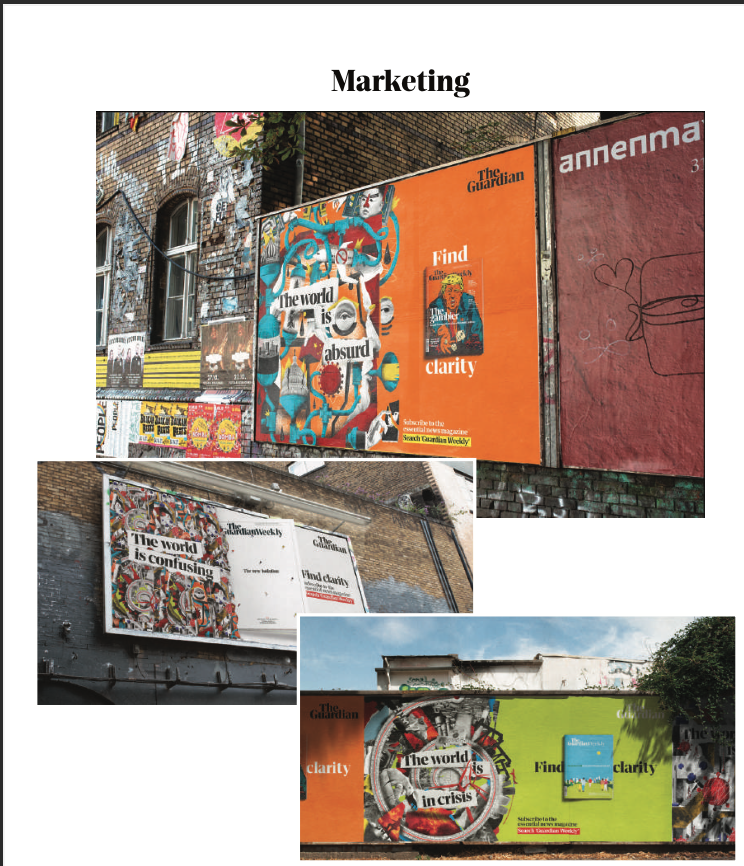

The Guardian
‘Find Clarity’ campaign
Since lockdown and coronavirus restrictions were imposed around the world, demand for Guardian Weekly, The Guardian’s international news magazine, had seen a 15% growth in its subscription base. It suggested that print still had some staying power, though, people may want news in another form to a daily newspaper.
To capitalise on this and attract more subscribers, The Guardian ran innovative outdoor campaigns in cities across Europe, presenting the Guardian Weekly as a way for readers to digest global news differently. The Drum reported that the campaign, illustrated by surrealist artist Rafael Alejandro, depicted three global news events – coronavirus, Trump and the environment.
Each design runs with an accompany- ing statement that ‘the world is…’ ‘confusing’ (coronavirus), ‘absurd’ (Trump), and ‘in crisis’ (the environment). The cover of this week’s Guardian Weekly appears next to the illustra- tions, inviting people to ‘find clarity’, with
the clustered imagery juxtaposed against the calm, clear Guardian Weekly magazine.
The ‘street takeover’ style, with striking billboards, also formed a central part of The Guardian’s ‘Work in Progress’ campaign, launched to celebrate the paper’s 200th anniversary in 2021.
USA Today Network/ Gannett
Campaign to Showcase Our Journalism’s Impact in Local Communities
Gannett’s USA Today Network is the largest local-to-national digital media organization in the U.S. The national daily USA TODAY sits at the centre of this network, with over 300 local digital properties across 46 states. Gannett’s campaign sought to show- case the strength of this local connect, with thousands of reporters across its network reporting on the cultural moments shap- ing communities — over the years and right through the chaos and uncertainty of 2020. “We did this by telling the story of our journey together. We have deep roots in our local communities, many dating back nearly 200 years. The campaign focused on issues that faced us both in the past and in 2020 as proof points that our journalists have always been and will always be at the center of each communities’ stories unfolding,” the publish- er wrote in a note describing the campaign. To juxtapose the past and present, the USA Today network utilised its extensive photo archives to showcase the longevity of cover- age, whether through the lens of civil rights or the unfolding health crisis.
The campaign was launched in twenty of the network’s largest markets with print ads and a digital campaign that featured interactive and seamless scrolling from image to image, to explore comparison and similarities between two moments in history. It campaign drove over 39 million impressions and 31,000 subscriptions across the network, Gannett submitted at the 2021 INMA awards.
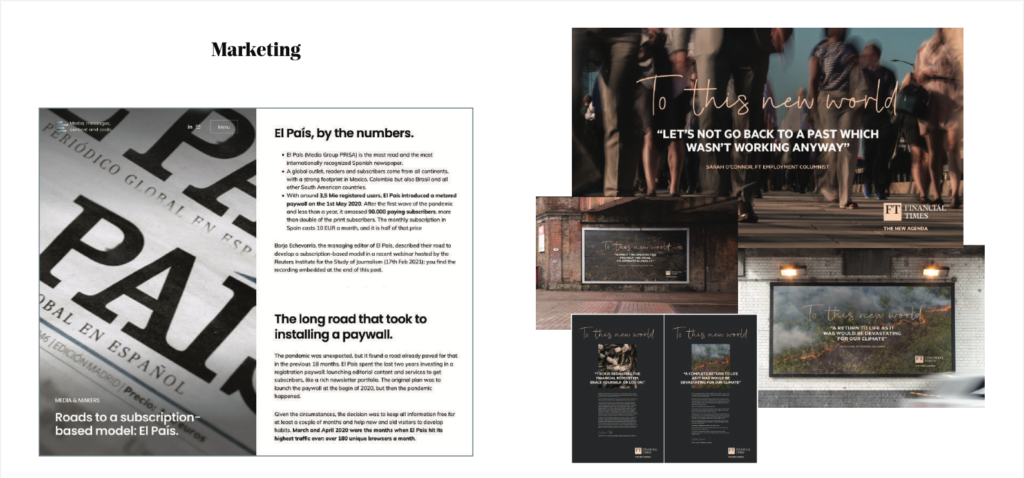
El Pais
Launch of a metered paywall during the Coronavirus pandemic
For other publishers, circumstances can collude to provide an organic push toward changing strategy. Spain’s El Pais, one of the country’s highest circulated newspapers, had been planning to move its digital content behind a paywall since 2017-18. After much debate, the date for the launch of the paywall was initially set for March 1, 2020, but when Covid-19 hit just a month before the launch, a decision was made to change strategy.
Managing editor Borja Echevarría, speaking at a webinar organised by the Reuters Institute for the Study of Journalism, said the publication saw an opportunity to build a stronger relationship with readers rather than starting the paywall straight away. During March and April, the team built a different narrative similar to a membership model. “We told them we were not starting the paywall but people could still subscribe and start paying.” This was also the time El País saw its highest numbers in terms of traffic with 180 million unique visitors and 1 billion page views in April 2020.
“We thought we could spend those months showing the importance of the kind of journalism we do and in many ways I think instead of a traditional marketing campaign the Covid-19 pandemic became our best communications and marketing campaign,” Echevarría added. El Pais’ paywall was, of course, a runaway success with the publication going from zero to over 100,000 paying subscribers by mid- 2021.
Financial Times
“Letters to This New World”
Launched in late September 2021, The Financial Times’ new campaign, “Letters to This New World”, calls on readers to reflect on life before and after the pandemic and hopes to give a voice to the lessons learned as we look to shape the future.
Developed by The Brooklyn Brothers agency, the campaign is part of the evolution of the FT’s ‘New Agenda’ brand platform, which promotes the newspaper as the “leading destination for analysis and leadership on the most important global trends and themes”, art and design magazine Creative Boom reported.
The ads feature a series of hard-hitting open letters addressing serious themes like climate change, the world of work, digital finance and global inequality. FT journalists including Martin Wolf, Gillian Tett, Pilita Clarke, John Burn-Murdoch, Sarah O’Connor and Paul Murphy have all contributed.
Interestingly, Creative Boom reported that all FT employees were invited to contribute to the campaign while members of the public will also be invited to submit their own letters, with the strongest contributions to be featured in future advertisements. “The pandemic has given everyone pause to reflect on what matters in life and how we could organise ourselves differently in future,” says Finola McDonnell from the FT. “We wanted to capture some
of those reflections and put them out there for business leaders and those in positions of power to think about and act upon. We are at an inflection point, and the FT is positioned to encourage and lead a debate about what comes next.”
The campaign comes after a record 2020 for the Financial Times when readership and subscriptions saw a surge as the pandemic took hold globally.
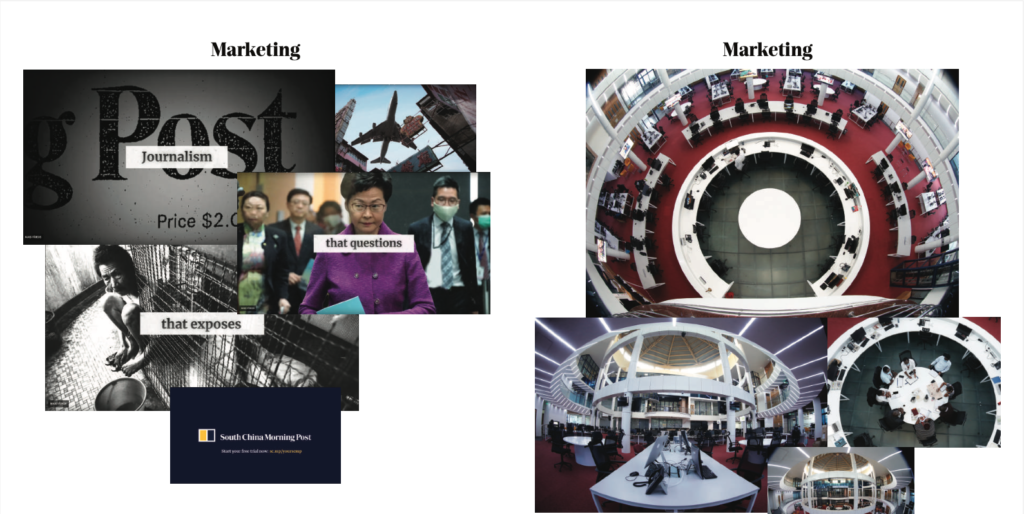
South China Morning Post
Your Hong Kong Your SCMP
SCMP’s objective with this brand campaign was to showcase its history of reporting on the issues that matter to local readers. The campaign was launched at a critical time for the newspaper, coming just ahead of the publication bringing back its digital paywall in May 2020 as revenues began to fall.
“Reminding our audience that we have supported Hong Kong with balanced, truthful news for over a century was a major requirement in communicating a reason to believe in and purchase our digital subscription product,” SCMP submitted at the 2021 INMA awards.
Over the last three years SCMP has expanded operations into North America, Southeast Asia and Europe. Even as it evolves into a global news brand, the purpose of the campaign was to remind Hong Kong readers that despite this growth, SCMP remained committed to covering the stories that matter in its home base. The campaign sought to balance a legacy element, with plenty of nostalgia from SCMPs historic reporting, with a look and feel that was younger and nodded to the organisation’s willingness to embrace digital transformation. “During the 2-week period where our brand campaign launched and was live, SCMP achieved over 1 million organic house ad and video impressions which resulted in a 106% increase in paid subscriptions,” the publisher reported. Through the campaign it also discovered that Hong Kong readers were the largest audience segment purchasing subscriptions.
The Standard Group
Project Eagle
In some cases, a great marketing campaign takes years to define and requires structural change within the organisation. Project Eagle is the name given to the campaign that surrounded the launch of the paid-for digital content strategy launched by Kenya’s Standard Group in 2020 and 2021. The underlying work for the campaign started in 2017, with the group unveiling several projects across traditional and digital media platforms. This included the launch of three radio stations and an extreme makeover of the website and the newspaper to make them more user-friendly. The initiative was crowned by the unveiling of a modern converged newsroom in 2020 which would see journalists and editors seamlessly connect on various digital platforms.
Project Eagle was selected as a winner at WAN-IFRA’s 2021 African Digital Media Awards in the category of best brand aware- ness campaign. “What is interesting about this campaign is the preparatory work done to understand the users in order to define messages that will convince readers to pay. Six months after the launch of the paywall, Standard had the outstanding results of convincing almost 400,000 users to register and 5% of them to pay,” the jury noted.


